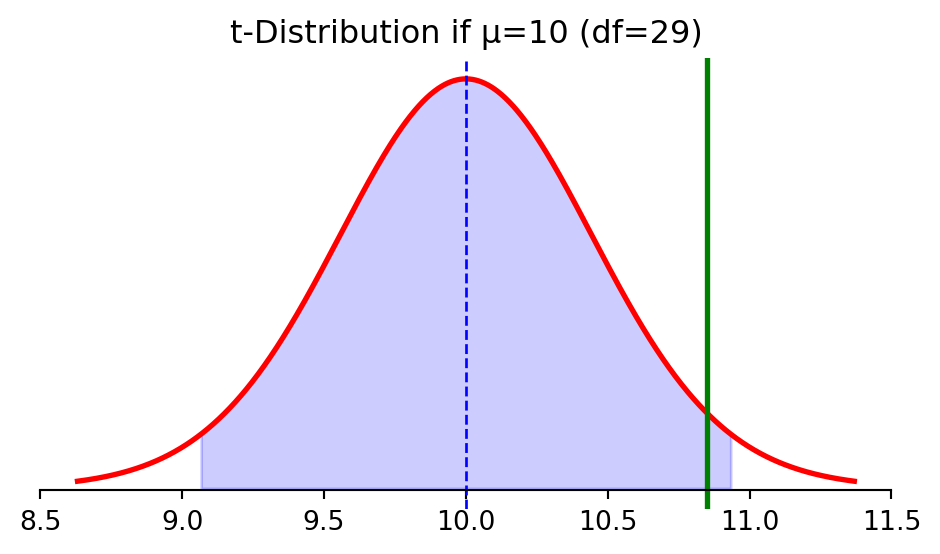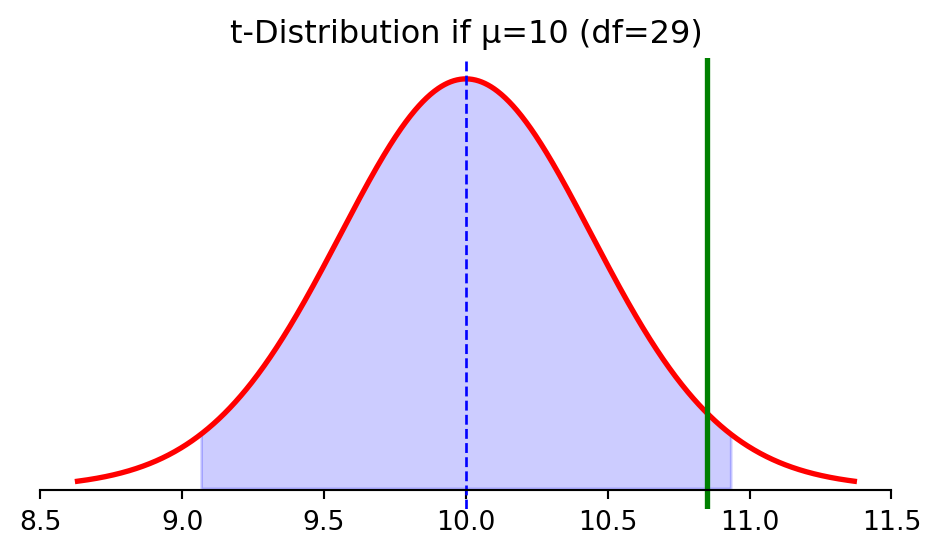
ECON 0150 | Economic Data Analysis
The economist’s data analysis skillset.
Part 3.4 | Hypothesis Testing
A Big Question
How do we learn about the population when we don’t know \(\mu\) or \(\sigma\)?
- Part 3.1 | Known Random Variables
- If we know the random variable, we can answer all kinds of probability questions
- Part 3.2 | Sampling and Unknown Random Variables
- The sample means of unknown random variables will approximate a normal distribution around the truth
- Part 3.3 | Confidence Intervals
- We can use the sampling distribution to know the probability that the sample mean (\(\bar{x}\)) will be close to the population mean (\(\mu\))
Sampling Distribution: Unknown \(\mu\); Known \(\sigma\)
If we know the population mean, we know the sampling distribution is approximately normal.
- The sample mean is drawn from an approximately normal distribution with mean \(\mu\) and standard error \(\sigma / \sqrt{n}\).
- Each time we draw a sample we see a different sample mean.
- What do we do that we don’t observe \(\mu\)? We measure ‘closeness’.
Unknown \(\mu\): Two Perspectives
There are two mathematically equivalent perspectives to think about “closeness” between \(\mu\) and \(\bar{x}\).
Perspective 1: probability \(\bar{x}\) is close to \(\mu\)
Perspective 2: probability \(\mu\) is close to \(\bar{x}\)

> if \(\bar{x}\) is in the CI around \(\mu\), then \(\mu\) will be in the CI around \(\bar{x}\)!
Unknown \(\mu\): Two Perspectives
There are two mathematically equivalent perspectives to think about “closeness” between \(\mu\) and \(\bar{x}\).
I repeatedly sampled a distribution and constructed a 95% confidence interval.

> the samples with \(\bar{x}\) in the CI around \(\mu\) have \(\mu\) in the CI around \(\bar{x}\)
Unknown \(\mu\): Two Perspectives
There are two mathematically equivalent perspectives to think about “closeness” between \(\mu\) and \(\bar{x}\).
I repeatedly sampled a distribution and constructed a 95% confidence interval.

> it is mathematically equivalent to check whether \(\mu\) is in the CI around \(\bar{x}\)!
Unknown \(\mu\): How ‘close’ is \(\mu\) to \(\bar{x}?\)
The distance between \(\bar{x}\) and \(\mu\) works both ways.
Now we can use the Sampling Distribution around \(\bar{x}\) to know the probability that \(\mu\) is any distance from \(\bar{x}\).

> same distribution shape, just different reference points
Unknown \(\mu\): How ‘close’ is \(\mu\) to \(\bar{x}?\)
Each sample gives us a different \(\bar{x}\) and \(S\).

> notice both \(\bar{x}\) (red lines) and \(S\) vary across samples
> each sample creates its own confidence interval for where \(\mu\) could be
> now we know the probability \(\mu\) is in the CI around \(\bar{x}\)!
Unknown \(\sigma\): How ‘close’ is \(\mu\) to \(\bar{x}?\)
Each sample gives us a different \(\bar{x}\) and \(S\).

> but here we’re creating the Confidence Intervals using a known \(\sigma\), which we will never actually observe
> each sample has a different \(S\)!
Unknown \(\sigma\): Variability of \(S\)
Just like \(\bar{x}\) varies around \(\mu\), the \(S\) varies around \(\sigma\).

> we centered the Sampling Distribution on \(\bar{x}\) instead of \(\mu\)
> what would happen if we used the \(S\) in place of \(\sigma\) as a guess?
Exercise 3.4 | Sampling Variation in \(S\)
Will a 90% confidence interval using \(S\) in place of \(\sigma\) correctly contain roughly 90% of the population means?
Samples (\(n=5\)) with the sampling distribuion centered on the population mean to show the differences in each samples’ spread.

Exercise 3.4 | Sampling Variation in \(S\)
Will a 90% confidence interval using \(S\) in place of \(\sigma\) correctly contain roughly 90% of the population means?
Simulate many samples and check how often the 90% confidence interval contains the population mean when we simply swap \(S\) for \(\sigma\).
> theres an additional layer of variability in the sampling distribution coming from the variability in the sample standard deviation (\(S\))
Exercise 3.4 | Sampling Variation in \(S\)
Using the normal distribution with \(S\) gives wrong coverage rates (n=15).

> we would predict 90% when the actual number is lower (87.5%)
> we would be too confident if we use the Normal with \(S/\sqrt{n}\)
Exercise 3.4 | Sampling Variation in \(S\)
Will a 90% confidence interval using \(S\) in place of \(\sigma\) correctly contain roughly 90% of the population means?
Samples (\(n=5\)) with the sampling distribuion centered on the population mean to show the differences in each samples’ spread.

Exercise 3.4 | Sampling Variation in \(S\)
Will a 90% confidence interval using \(S\) in place of \(\sigma\) correctly contain roughly 90% of the population means?
Samples (\(n=30\)) with the sampling distribuion centered on the population mean to show the differences in each samples’ spread.

> as the sample size grows (now n=30), this variability gets smaller
> but we’ll always use a t-Distribution instead of a Normal for testing
Unknown \(\mu\) and \(\sigma\): Building Models
What if we want to test a specific claim about the unobserved population mean?
Is our data consistent with the following specific claim?
- “The mean wait time is 10 minutes.”
> instead of finding where some \(\mu\) might be, we’re testing a specific value of \(\mu\)
Example: Wait Times
If \(\bar{x}=10.85\), is that consistent with \(\mu_0=10\)?
If sample standard deviation is \(s = 2.5\):
\[SE = \frac{s}{\sqrt{n}}\]
\[SE = \frac{2.5}{\sqrt{30}}\]
\[SE = 0.456\]

Example: Wait Times
The math to answer this question is identical to confidence intervals.
If sample standard deviation is \(s = 2.5\):
\[SE = 0.456\]
If true mean is \(\mu_0 = 10\):
\[\bar{x} \sim t_{29}(10, 0.456)\]
So the critical value for 95%: \[t_{crit} = 2.045\]

Example: Wait Times
The math to answer this question is identical to confidence intervals.

A 95% confidence interval around \(\mu_0\) would be: \([9.07, 10.93]\)
> our observed mean (\(\bar{x} = 10.85\)) is within this interval — not surprising if μ=10
> but if we observed \(\bar{x} = 11.5\), that would be outside the interval — surprising!
The Null Hypothesis
We formalize this approach by setting up a “null hypothesis”
Null Hypothesis (\(H_0\)): The specific value or claim we’re testing
- \(H_0: \mu = 10\) (wait time is 10 minutes)
Alternative Hypothesis (\(H_1\) or \(H_a\)): What we accept if we reject the null
- \(H_1: \mu \neq 10\) (wait time is not 10 minutes)
Testing Approach:
- Calculate how “surprising” our data would be if \(H_0\) were true
- If sufficiently surprising, we reject \(H_0\)
Quantifying Surprise: p-values
The p-value measures how compatible our data is with the null hypothesis.
p-value: The probability of observing a test statistic at least as extreme as ours, if the null hypothesis were true
For our example:
- Null: \(\mu = 10\)
- Observed: \(\bar{x} = 10.85\)
> How likely is it to get \(\bar{x}\) this far or farther from 10, if the true mean is 10?
Quantifying Surprise: p-values
Example cont.: What is the probability of an error as large as the observed mean?
> how likely is it to get \(\bar{x}\) this far or farther from 10, if the true mean is 10?

> interpretation: if μ=10, we’d see \(\bar{x}\) this far from 10 about 7.2% of the time
> often, we reject \(H_0\) if p-value < 0.05 (5%)
> here, p-value > 0.05, so we don’t reject the claim that μ=10
Test Statistic: The t-statistic
We can standardize our result for easier interpretation
The t-statistic measures how many standard errors our sample mean is from the null value:
\[t = \frac{\bar{x} - \mu_0}{s/\sqrt{n}}\]
Where:
- \(\bar{x}\) is our sample mean (10.85)
- \(\mu_0\) is our null value (10)
- \(s\) is our sample standard deviation (2.5)
- \(n\) is our sample size (30)
Test Statistic: The t-statistic
We can standardize our result for easier interpretation
The t-statistic measures how many standard errors our sample mean is from the null value:
\[t = \frac{\bar{x} - \mu_0}{s/\sqrt{n}} = \frac{10.85 - 10}{2.5/\sqrt{30}} = \frac{0.85}{0.456} = 1.86\]
Where:
- \(\bar{x}\) is our sample mean (10.85)
- \(\mu_0\) is our null value (10)
- \(s\) is our sample standard deviation (2.5)
- \(n\) is our sample size (30)
The t-test
This example has become a formal hypothesis test.
One-sample t-test:
- \(H_0: \mu = 10\)
- \(H_1: \mu \neq 10\)
- Test statistic: \(t = 1.86\)
- Degrees of freedom: 29
- p-value: 0.072
Decision rule:
- If p-value < 0.05, reject \(H_0\)
- Otherwise, fail to reject \(H_0\)
> t-tests are a univariate version of regression
Statistical vs. Practical Significance
A caution about hypothesis testing
Statistical significance:
- Formal rejection of the null hypothesis (p < 0.05)
- Only tells us if the effect is unlikely due to chance
Practical significance:
- Whether the effect size matters in the real world
- A statistically significant result can still be tiny
> with large samples, even tiny differences can be statistically significant
> always consider the magnitude of the effect, not just the p-value
Common Misinterpretations
What a p-value is NOT
❌ Not: The probability that \(H_0\) is true
- The p-value doesn’t tell us if the null hypothesis is correct. It assumes the null is true and then calculates how surprising our result would be under that assumption.
- Example: A p-value of 0.04 doesn’t mean there’s a 4% chance the null hypothesis is true.
Common Misinterpretations
What a p-value is NOT
❌ Not: The probability that the results occurred by chance
- All results reflect some combination of real effects and random variation. The p-value doesn’t separate these components.
- Example: A p-value of 0.04 doesn’t mean there’s a 4% chance our results are due to chance and 96% chance they’re real.
Common Misinterpretations
What a p-value is NOT
❌ Not: The probability that \(H_1\) is true
- The p-value doesn’t directly address the alternative hypothesis or its likelihood.
- Example: A p-value of 0.04 doesn’t mean there’s a 96% chance the alternative hypothesis is true.
Common Misinterpretations
What a p-value is NOT
✅ Correct: The probability of observing a test statistic at least as extreme as ours, if \(H_0\) were true
- It measures the compatibility between our data and the null hypothesis.
- Example: A p-value of 0.04 means: “If the null hypothesis were true, we’d see results this extreme or more extreme only about 4% of the time.”
> think of it like this: The p-value answers “How surprising is this data if the null hypothesis is true?” not “Is the null hypothesis true?”
Looking Forward: Bivariate GLM
This framework extends directly to regression analysis.
Next time:
- Bivariate GLM: Comparing means between two groups
> the hypothesis testing framework is foundational for modern science
Looking Forward: Regression
This framework extends directly to regression analysis.
Today’s model: \(E[y] = \beta_0\) (just an intercept)
Next: \(E[y] = \beta_0 + \beta_1 x\) (intercept and slope)
- Each \(\beta\) coefficient will have its own t-test
- Same framework: estimate ± t-critical × SE
- The t-distribution accounts for uncertainty in our estimates
> regression is just an extension of what we learned today
Summary
We’ve built the foundation for statistical modeling.
- Flipped perspective: center on what we observe (\(\bar{x}\)) not what’s unknown (\(\mu\))
- Sample SD varies, creating need for t-distribution
- Built our first model: \(E[y] = \beta_0\)
- Tested hypotheses by shifting data
- Connected hypothesis tests to confidence intervals
> these tools form the foundation of econometric analysis